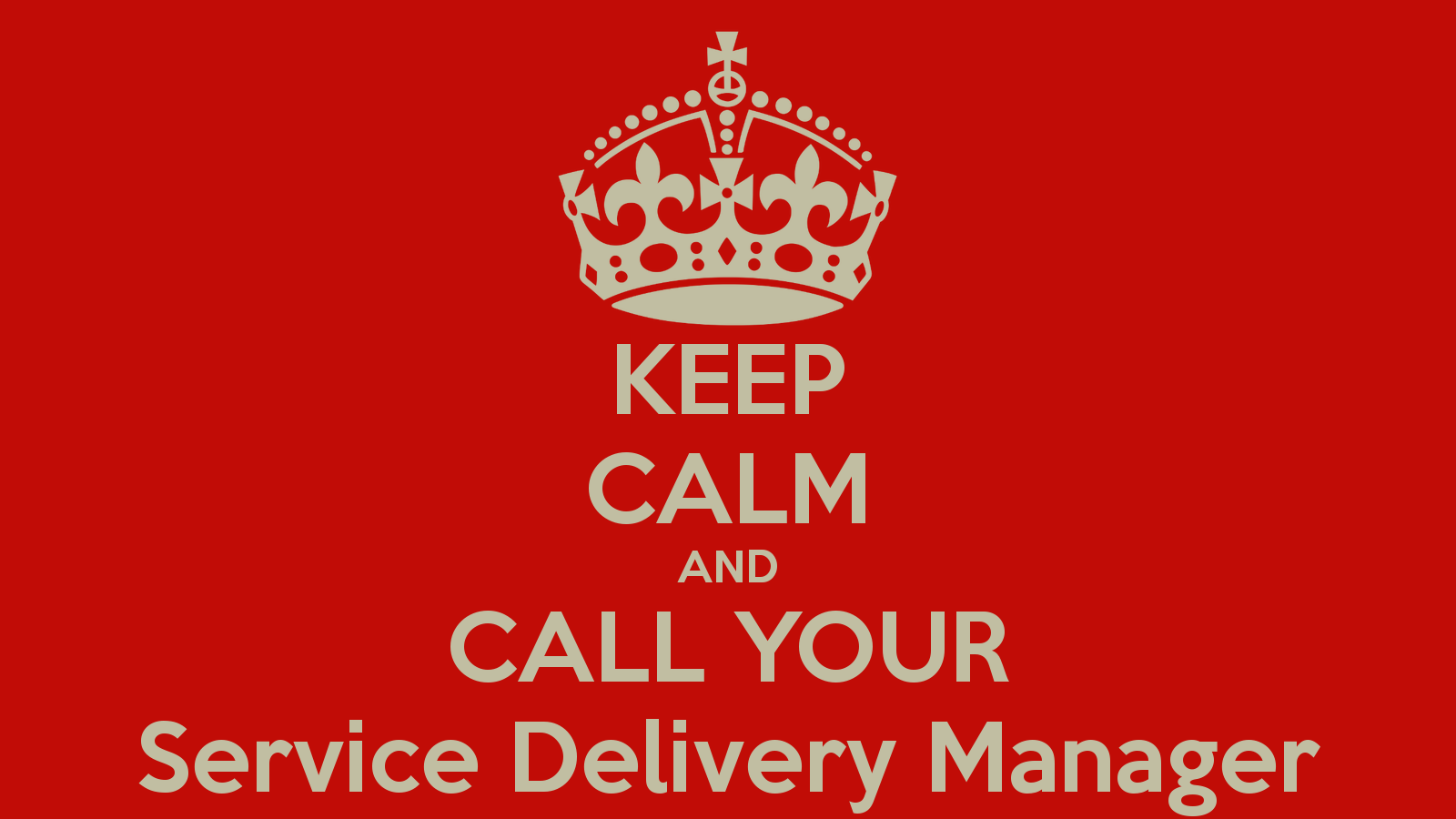If you read any of the ITIL Best Practice books you will not find one mention of a Service Delivery Manager (SDM).
It's not even mentioned in the ITIL4 Foundation book, but the role still exists in many organisations around the world.
If you 'Google' IT Service Delivery Manager jobs there are thousands of jobs on various job boards around the world.
The role and responsibilities of a multi-functional Service Delivery manager are certainly documented within the 1,500-odd pages of IT Service Management Best Practice. You just need to know where to look.
I think it is fair to state that it’s not a ‘one size fits all’ role. IT departments come in various shapes and forms, small, medium or large, and internal, shared and outward facing.
You may be a SDM who works in a Managed Service Provider environment and have external customers with whom you have a commercial relationship, you may even be embedded to some extent within their organisation.
Alternatively you may be a SDM with just one or more internal customers within the business of your own organisation.
Whatever you’re particular SDM role, there will be a number of common issues that the majority of SDMs face, so we have put together our thoughts and experience to develop our own brand of SDM ‘Best Practice’
(You might also want to reads this post: What is ITIL Service Management?)
My Top 10 Tips for Becoming an Effective IT Service Delivery Manager
In no particular order are…
1) To start with you need to develop a clear understanding of your Role and Objectives. As previously discussed, this will depend on your organisation, its strategic goals and structure and your place within it and your customer base.
It’s important that you have a clear role and job description that defines your accountabilities and responsibilities and how they map both internally on to the various support teams and management structure, but also externally in terms of the management of communications with your customer base.
To be effective it’s important that you really understand your role and it’s also just as important that others both internally and externally understand your role. If not you’ll get dragged into things which aren’t your responsibility. That said, if others aren’t ‘playing the game’ or there are gaps in the organisational structure, then that needs to be flagged up to management.
2) Remember that you represent not just the service provider to your customer, you also need to represent and be seen to represent the customer to the service provider. It is a difficult task to ensure that you are not just ‘sitting on the fence’ or even ‘piggy in the middle’.
If you are embedded within your customers organisation, it may be perceived that on occasion you may be seen as ‘going native’, especially if you vociferously protect or support your customer against your colleagues in the service provider. Ideally you need to be proactive, open, honest and fair with your representations to both your customer and service provider.

3) We said previously that you need to have clearly defined responsibilities, but over time you will find that the boundaries of your role will flex depending on changes in strategic business goals and direction. The role of a service delivery manager is primarily split into that of a ‘tactical’ Service Level Manager (SLM) and a ‘strategic’ Business Relationship Manager (BRM).
Where the SLM and BRM roles don’t actually exist in your organisation, then I’m sorry to say but you’re responsible for one or another or both. I’ve seen lots of papers saying that the role of SDM needs to be broken up into an SLM and BRM role, but that doesn’t have to be the case especially in smaller organisations where there may not be the budget or headcount available.
- The SLM part of your role is about ensuring that agreed Service Level Targets are met on an ongoing basis and reported on through service level reports and service review meetings.
- The BRM part of your role is to ensure that customer satisfaction levels are maintained and improved, and it’s vitally important to develop a clear understanding of your business partner’s IT strategy and their overall corporate strategy.
4) You need to ensure you have the backing of those who ultimately provide the support for the services that you are fronting.
Not just moral support but real technical support. Service provisioning is a team challenge and you need to understand the service provider’s internal organisational support capabilities (documented in Operational Level Agreements (OLAs), and balance them against the businesses’ service level requirements.
So as well as ensuring that we have SLAs in place documenting service level requirements we should ensure that all the OLAs are in place to monitor and report on internal support capabilities and service delivery.
5) Rather than use the Service Level Agreements as a stick to beat up the customers or for them beat us up with, they should be used as an open, honest and transparent driver and an interface between service provider and the customer/business.
The SLA discussions (service review meetings) should allow us the opportunity to ensure we can develop a real and long-lasting ‘win-win’ opportunity. It should be possible for both parties to discuss their individual business challenges and strategic goals in an atmosphere of mutual benefit.
(Before we go on, you might be interested in reading this post about the roles of a service transition manager).

6) We’ve all experienced a ‘high maintenance’ or ‘whinging’ customer and done our best to avoid them. If handled correctly, your biggest critics can become also become your biggest advocates.
If customer complaints can be resolved to the mutual satisfaction of both parties then it is possible to turn a sticky situation around.
All it takes is openness, honesty and transparency… oh and good relationship building and excellent communication skills… which is probably what they employed you for.
7) If suppliers are part of your service supply chain they should also be part of your value network, and as such the service interfaces should be seamless and transparent to the customer, after all it could have been you who sub-contracted part of the service…not your customer.
To ensure this seamless interface you will need to ensure that the contractual agreements underpin your SLAs and don’t contradict them.
If you have a supplier management function you will need to forge a good relationship which involves understanding their goals and challenges.

8) Another challenge you will no doubt experience (especially if SLM and BRM posts don’t exist) is how can you operate tactically and at the same time strategically? How do you maintain Customer satisfaction at the same time you’re failing you SLA targets.
Again the key is about being open, honest and transparent. When targets have been breached or near misses have occurred, discuss setting up a service improvement plan (SIP) in collaboration with your customer and internal support staff.
Now who funds the service improvements will depend on what is in place between you and your customer, a legal contract or an internal company agreement.
9) Firefighting is for firemen, not IT service delivery managers. It isn’t the role of an SDM to get your hands dirty fixing infrastructure or software, unless your organisation is so small that you have to multitask.
In the case of a major incident the role of the SDM is to communicate with your customer, keeping them appraised of progress and managing their expectations.
To do this you will need a good working relationship with your internal support teams or whoever is managing the external supplier if that is where the root cause resides.

10) Where the role of the SLM and BRM are clearly and unambiguously defined and the positions currently exist and are filled, then the role of service delivery management will sit between them and will tend to be one of ‘day-to-day’ contact for supply and support challenges even operating in an operational/tactical space between the Service Desk and the SLM.
You will be instrumental in effective communication with the customer keeping them appraised of progress with incidents and problems and service requests.
Basically you are key to driving operational effectiveness. In this type of SDM role your hands-on experience and knowledge is critical in supporting both the SLM and BRM roles.
I hope our tips have been useful? If you disagree or wish to add to our article then please let us know your thoughts. If you want to test your knowledge of IT Service Delivery Management, why not try our Service Delivery Manager Quiz to test out your skills and knowledge?
If we have stirred your interest in the role of the Service Delivery Manager then why not join us on our 2-day IT Service Delivery Manager Workshop to explore current Service Delivery Management ‘Best Practice’.
Or, if you want to start ad the very beginning you could take a look at the Purple Griffon ITIL v4 Foundation course.




